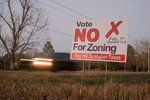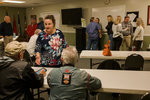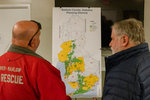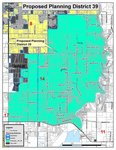The mail that day brought worrisome news.
A letter arrived announcing plans for an apartment complex on Lawrence Road near Elizabeth Wilson's home. Soon after, she noticed neighborhoods were also …
This item is available in full to subscribers.
Please log in to continue |






The mail that day brought worrisome news.
A letter arrived announcing plans for an apartment complex on Lawrence Road near Elizabeth Wilson's home. Soon after, she noticed neighborhoods were also popping up in fields that had once been home to crops, animals and families she grew up with as a fifth-generation Baldwin County resident.
So, she went to community meetings. She learned about zoning laws. Now, she is helping to lead the fight to limit and regulate the amount of construction that encroaches upon her family's legacy.
"People are interested. People are worried. Everywhere you drive you see new development, you see expansion, and you ask how is this happening," Wilson said.
Since 2020, nine communities have addressed the issue of zoning, or rather lack of zoning, in their rural Baldwin County neighborhoods.
As developers look away from crowded city centers along the Eastern Shore and in the county's coastal region, wide open spaces in Baldwin's south and central farming communities are ripe for picking.
Many of these rural locations are unzoned, which means as long as a developer meets the county's technical requirements, which address concerns such as utility use, traffic plans and environmental impacts, essentially anything can be built. Developers are not required to examine whether a plan fits in with the character of the surrounding community or even makes sense in that spot.
The only way to stop it is to put zoning rules in place. Here, it is a grassroots process led by concerned citizens, not county employees.
And as many community organizers have found, convincing their neighbors to join the fight is not always easy.
"At first, nobody wanted zoning. Historically, people would tell you that no one is going to tell them what to do with their land," Wilson said. "But developers are running unchecked, and the only way to keep them in check is with zoning. People are finally starting to understand but there's still a lot of fear.
"People are scared they are going to lose their property rights," Wilson said. "But they are not really going to lose anything if this is done correctly."
HOW TO FIGHT
Installing zoning rules in an area is a citizen-driven process.
Matthew Brown, Baldwin County planning director, said the process allows the planning department to remain neutral while residents decide what is best for their community.
Community organizers must first work with the county to establish boundaries for their district, often distinguished by major roads or natural boundaries such as waterways. The group then has 120 days to get 10% of the registered voters in that district to sign a petition asking for a zoning vote to be held.
Once the signatures are verified by the county, the probate judge sets a date for a special election. If the majority of voters vote yes, a moratorium is placed on all new construction that had not yet been approved.
A no-vote means the issue is dropped for two years, and development can continue.
In districts where the measure does pass, five representatives are picked from the area to serve on a committee that spends eight weeks writing the district provisions that will dictate what development they want or do not want to allow in their district.
Districts are often able to clarify specifics such as where apartments are allowed to be built and that businesses need to be kept near high-density intersections. The proposals are sent to the county commission for review and made law once commissioners approve.
Brown compares introducing zoning to a game of backyard baseball.
"The kids go out and play baseball in the backyard and have a bunch of unwritten rules that govern the game. A new kid moves in and wants to change the rules, and everybody gets upset, but there is no rule book," he said.
The same happens in zoning. Everyone in a community may know how they want their neighborhoods to look, but there are no written rules stopping a new neighbor from arriving and changing the rules.
"There is nothing for the county to enforce. They come to us, and we can say we understand this is not what the community wants, and we respect that, but there is nothing we can legally do," Brown said. "Zoning is a way to put rules in place for how the game is played in your community."
He stressed that zoning does not mean going from no rules to rules. Rather, zoning adds guidance that governs the character and compatibility of a project.
Brown said putting those decisions directly in the hands of community members is the best way to protect the vision of the people who live and work there every day.
"One dangerous thing planners often do is assume they know what is right for communities. That is not a position we take in our office," he said. "We have such a diverse county, and the beauty of a flexible system is it is not a one-size-fits-all solution.
"This allows those areas to, over time, have that community awareness and have a more active voice in how their community is going to develop. It is a painful process, and it is a little messy, but it seems to help keep our office from putting ourselves in a situation where we may be hurting a community by forcing rules that might hinder development that place really needs."
WHEN ZONING FAILS
When District 38 voted in December, less than 400 of the area's 1,500 residents came to the polls. The vote failed by less than 50 votes.
District 38 is a small, L-shaped region that falls on the west and south sides of US 98 down to Weeks Bay.
Now, residents there cannot resubmit a zoning request for two years.
Organizer Melissa Nolte said a lot can happen in two years.
And, she is certain, it will.
Nolte said several new housing subdivisions have been proposed on the west side of US 98, and she is fears more are coming. The problem, she said, is not necessarily the houses. It's everything that comes with them.
"That's the part that people have a hard time recognizing. It's not just a subdivision. We're adding populations to the schools, and they have to provide services like grocery stores and doctors and more roads. Now more people need homes, so we have apartment complexes added," she said.
Nolte said people's fear of government control over their individual yards may have cost the entire district control over the whole neighborhood.
"There seems to be a big feeling that by allowing zoning you are giving up your personal property rights," she said. "You do give up some individual property rights, but the benefit is that you also enact some guidelines and rules for the community that protects the character of it. For me, personally, the benefit to the community was more important."
THE NEXT VOTES
This week, Marla Barnes, organizer in District 14, turned in the signatures needed to request a vote for zoning.
The district, which surrounds the town of Silverhill and stretches west to Fish River and south to Weeks Bay, is full of residents who would have previously fought against zoning, including Barnes.
"Who am I to tell someone else what they can do with their land, but it has gotten beyond that," Barnes said. "This is not just what can you do with your land but 'does this make sense?' Are you hurting the people of your community with what you are doing?
"I realized the community has no voice in what's going on," she said. "That's just appalling to me. We've lived here for 28 years and never anticipated the type of growth we're seeing now. It's the wild west right now. Anything can go anywhere, and that's actually going to hurt us in the long run."
While residents in District 14 wait for the green light on their vote, residents in District 39 head to the polls on Tuesday, Feb. 7.
Organizers in that district, which is loosely found between east Barnwell and Fish River, were moved to action after two subdivisions were announced. The first, Sherwood Grove, will place 166 homes on 50 acres. The second, South Bend, will place 260 homes on 100 acres.
Trey Wood, who is helping to organize efforts to get votes to the polls, said he is worried about the installation of water lines that will disrupt neighborhoods for miles around the two new construction zones. He is worried about quality of life in the high-density neighborhoods.
And he's worried that the zoning measure won't pass, that his quiet farm community will be forever changed by those the developers sell to. Those who never knew Baldwin County as it is now.
"If we don't get zoning now, in two years there may be 2,000 more voters that came from somewhere else, and they won't care about cows and horses and farmland. They'll be voting for zoning that might take away the things we want," Wood said. "What if they decide that farmer is making too much dust harvesting peanuts? The people that live here would rather have a say in how we expand and grow than a bunch of outsiders coming into a little subdivision and outnumbering us in the future."